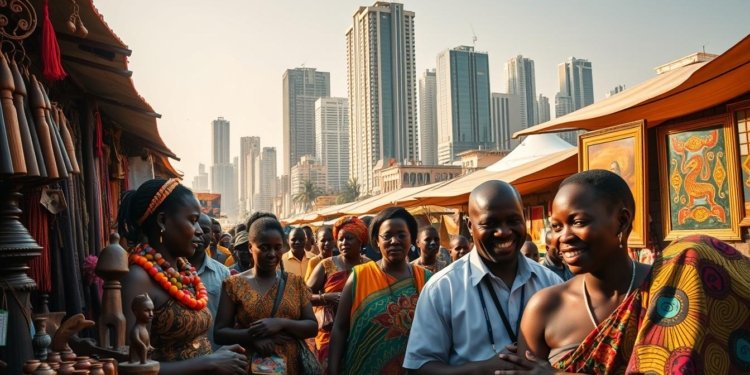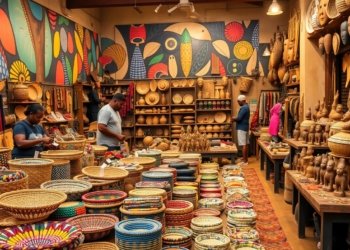Africa’s influence is growing rapidly, reshaping industries worldwide. With 10 of the fastest-growing economies and a population of 1.3 billion, the continent offers unmatched potential. Creative sectors like music, film, and fashion are leading this charge, proving that local talent can dominate global stages.
Take Afrobeats, for example—streams surged 550% on Spotify since 2017. Nollywood’s “The Black Book” cracked Netflix’s Top 10, while Burna Boy made history with a UK #1 album. These wins highlight a clear trend: the world is eager for Africa’s vibrant expressions.
But how can businesses tap into this momentum? Strategic partnerships, like Burberry’s collaboration with Afrobeats artists, show the power of blending tradition with innovation. With the IMF projecting 6.5% growth for sub-Saharan Africa by 2025, the time to act is now.
Key Takeaways
- Africa hosts 10 of the world’s fastest-growing economies.
- Creative industries generate $2.25 trillion globally.
- Afrobeats streams grew 550% on Spotify since 2017.
- Nollywood’s “The Black Book” reached Netflix’s Top 10.
- Strategic partnerships unlock new markets.
The Growing Global Demand for African Cultural Exports
Global markets are craving authentic creativity from the continent. With 69% of U.S. music listeners engaging with non-U.S. artists, the appetite for diverse talent is undeniable. Afrobeats fans, for instance, spend 121% more on music than average listeners—proof of a lucrative niche.

Why This Is a Lucrative Opportunity
Nigeria’s 200 million population fuels Nollywood and Afrobeats, making it a powerhouse. Spotify streams for these genres surpassed 1 billion, while Netflix’s “The Black Book” hit global Top 10. Such wins reveal a clear trend: consumers value originality.
Digital tools amplify reach. Broadband expansion lets creators share work instantly. Free market research resources, like Nigeria’s exporter toolkit, lower entry barriers for newcomers.
Economic Growth and Market Potential
The region’s $6.8T GDP (PPP) hints at untapped revenue. By 2025, 150 million people will earn over $5k annually—boosting spending power. Urbanization drives demand, too. Lagos’ plastic material needs grew 18% last year alone.
Quality standards matter. Gabon’s strict conformity certificates ensure exports meet global benchmarks. Meanwhile, South Africa’s BEE policies guide foreign investors toward sustainable partnerships.
Key Sectors for Exporting African Culture
Streaming platforms and fashion runways now spotlight Africa’s untapped potential. From music to film, creative industries drive economic growth while sharing unique stories. Here’s how three sectors lead the charge.
Afrobeats: The Soundtrack of a Cultural Revolution
Artists like Rema prove Africa’s sound is unstoppable. His hit “Calm Down” became the first African-led track to hit 1 billion streams. Spotify’s Afrobeats Cities playlists now dominate 67% of music industry revenue.

Nike tapped into this wave with Afrobeats-themed Jordan sneakers. Such collaborations show how global companies leverage local talent. Streaming services fuel this growth, making artists household names.
Nollywood: Africa’s Booming Film Industry
Nigeria’s film sector produces over 2,500 movies yearly. Amazon Prime’s “Gangs of Lagos” redefined production standards, while “The Black Book” reached Netflix’s Top 10 in 38 countries. Budgets now soar from $60k to $1M per project.
Jáde Osiberu’s Prime Video deal highlights demand for premium content. TalentX Africa’s financing model also empowers filmmakers. These strides prove Nollywood’s $7.2B GDP impact is just the start.
Fashion and Art: Showcasing African Creativity
Ankara fabric’s bold prints now inspire global runways. UNESCO-recognized Tuareg jewelry blends tradition with modern design. Brands like Mami Wata, which won a Sundance award, push boundaries.
DSTV’s Showmax competes with Netflix, proving local platforms thrive. With $20B potential in creative industries, Africa’s influence is undeniable. The world is finally paying attention.
Overcoming Challenges in Exporting African Culture
Breaking into global markets comes with unique hurdles for regional creators. While demand grows, 11.3% export declines since 2014 show systemic barriers. From counterfeit goods to port congestion, solving these issues unlocks true potential.
Gabon’s strict anti-counterfeit laws prove effective against fake products. Yet piracy still plagues markets—over 80% of Nollywood DVDs are unauthorized copies. Stronger IP protection could safeguard creative incomes.
The pandemic hit craft exports hard when tourism dropped 72%. Meanwhile, Lagos port delays cost businesses $55 million daily. Better logistics partnerships can ease these bottlenecks.
Language divides complicate Francophone-Anglophone trade. Localized marketing and bilingual staff help bridge gaps. Programs like SACO’s Mzansi Golden Economy offer valuable insights for navigating these environments.
AI sparks debates as tools generate art faster than humans. However, South Africa’s racial equity rules remind us that authentic voices matter. Balancing technology with human creativity remains key.
Solutions exist. The AfCFTA simplifies customs processes across 54 nations. Digital tools like Africa Business Pages connect reliable partners. With smart strategies, these challenges become stepping stones.
Strategies for Success in Exporting African Culture Through Business
Strategic collaborations are unlocking new markets for regional talent. Businesses that blend local expertise with global demand see the fastest growth. From music to textiles, smart partnerships and compliance know-how turn potential into profit.
Building Partnerships and Leveraging Local Networks
Pepsi Nigeria’s ambassador program with Ayra Starr boosted brand relevance among youth. Such alliances merge corporate reach with cultural credibility. ABSA Bank’s export financing packages also help creators scale.
MultiChoice’s Talent Factory trains filmmakers, while Afropunk Festival connects diasporas. Platforms like Kente Cloud digitize craft sales, proving local networks amplify reach. DHL’s e-commerce solutions further streamline cross-border logistics.
Navigating Legal and Regulatory Frameworks
Morocco’s 30% film rebate lures international productions. ExportHelp.co.za demystifies trade compliance, and Flutterwave’s payment tools bypass currency hurdles. Ethiopian Airlines’ cargo routes ensure physical goods move smoothly.
The AfCFTA cuts red tape across 54 nations. COTTON AFRIC’s textile model shows how adhering to Gabon’s anti-counterfeit laws builds trust. For sustainable growth, understanding these frameworks is non-negotiable.
Conclusion
The world is embracing Africa’s creative power like never before. With Afrobeats and Nollywood driving $10B in export potential, the IMF’s 6.5% growth forecast underscores this momentum.
Strategic investments, like Afreximbank’s creative fund, can accelerate success. The Lagos-Accra corridor highlights regional collaboration, while UNESCO’s 2005 Convention safeguards heritage.
For businesses, the future lies in blending innovation with tradition. From AI-preserved oral histories to Twitch’s gaming boom, opportunities abound. Now is the time to act—authenticity meets global demand.
FAQ
Why is African culture gaining global attention?
The world is embracing African creativity, from music and film to fashion and art. Global audiences appreciate its authenticity, vibrancy, and unique storytelling.
What makes Afrobeats a strong export product?
Afrobeats blends traditional rhythms with modern sounds, making it appealing worldwide. Artists like Burna Boy and Wizkid have boosted its international reach.
How does Nollywood contribute to cultural exports?
Nollywood produces thousands of films yearly, telling African stories with universal themes. Streaming platforms like Netflix now feature its content, expanding its audience.
What challenges do businesses face when exporting African culture?
Common hurdles include logistics, intellectual property protection, and varying regulations. Building strong local partnerships helps overcome these obstacles.
How can businesses leverage African fashion trends globally?
Brands like MaXhosa and Christie Brown showcase African designs. Collaborations with international retailers help bring these styles to new markets.
What role do digital platforms play in cultural exports?
Social media and streaming services amplify reach. They allow creators to connect directly with global consumers, bypassing traditional gatekeepers.
Why is economic growth in Africa important for cultural exports?
A growing middle class fuels demand for creative industries. This domestic success often translates into stronger international appeal.
What legal considerations should exporters be aware of?
Trademarking creative works and understanding import/export laws are crucial. Consulting local experts ensures compliance across different regions.





